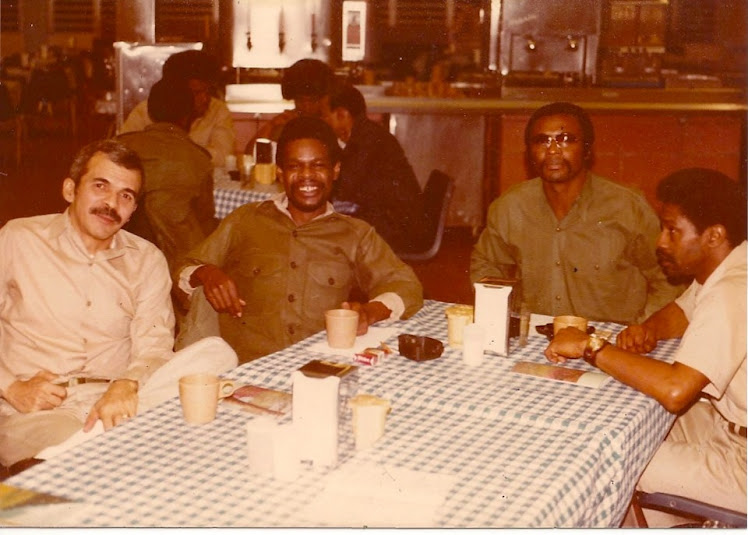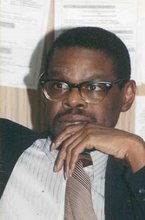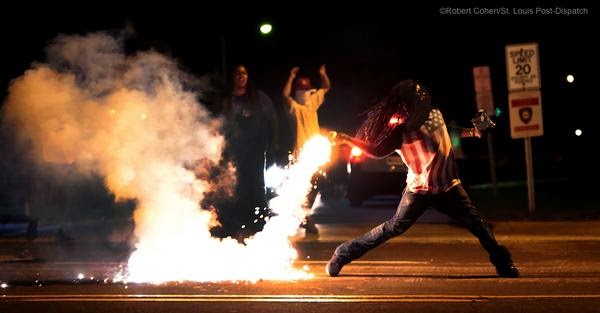As sun sets on another year, I wish to extend my blessings to all my friends and heroes.
To my friends at the People’s Law Office in Chicago, I send my utter heartfelt thanks for coming to the rescue of a group of prisoners, known at the Marion Brothers. And, to my lifetime friend Bonnie Kerness at the American Friends Service Committee, and the bulk of those who made up the prisoner rights movement, during the period of my incarceration (1972-1984).
I was pleasantly surprised to find the People’s Law Office archives on line. I fondly remember Dennis Cunningham trying to explain why Eddie Griffin hugged the warden as he came off the witness stand in Alton, Illinois, in 1984. I remember Mike Deutsch being so confounded that he has hardly spoken to me since. Nevertheless, they were my heroes, and their website preserves a proud testimony of the Marion Brothers.
Here are a few excerpts, I would hope to use in my memoirs.
We started the [People’s Law Office] because we wanted to work in the movement for the movement & with the movement as lawyers. Ted Stein brought the idea to Dennis Cunningham when they were working together in the Chicago Legal Defense Committee, formed to help deal with the protests at the ‘68 Democratic Convention, and the cases that came out of it. A week later when the smoke cleared, they were sitting in a room downtown with 300 misdemeanor cases, wondering what to do.
I used to keep Dennis in stitches whenever he came to visit me at the prison. I was always full of legal schemes. “And, you’re going to do WHAT?” Inevitable came his laughter. Together, we would chock the prison administration’s legal team, with legal babble they had never seen. We were great students of the law. And, there was always a bounty on our heads inside the prison system.
THANK YOU, People Law Office, for preserving these memories:
Dennis met Bobby Rush and Fred Hampton, who asked for help with the many legal problems the new Illinois Chapter of the Black Panther Party was already having
There ensued a baptism of fire. Dennis had his first jury trial in late February 1969, on one day’s notice, with Fred as his client in a case about a demonstration in Maywood City Council chambers the year before. By April, a high level of conflict had developed between the Panthers, the Young Lords and the Police, and a series of major confrontations had begun. Fred went to trial again (with other counsel) and was convicted of robbery for allegedly relieving a Maywood ice cream truck driver of his inventory and passing it out to neighborhood kids. After a vicious attack upon him in the press by State’s Attorney Edward V. Hanrahan, the trial judge reneged on a promise to put Fred on probation and instead sentenced him to two to five years in the penitentiary. Truly frightened at the possibility that it would be denied, we spent over a month preparing a petition for appeal bond, with law students Flint Taylor, Seva Dubuar and Ray McClain joining the effort to free Fred and defend the Panthers.
[Editor insert]
Meanwhile in Texas, Arlington State activist Ernie McMillian is charged with instigating a food riot. The food throwing incident was translated into robbery. Ernie, was facing 20 to life in the Texas prison system. He was our SNCC leader, and a close associate of Stokely Carmichael and H. Rap Brown, whose slogan “Burn, Baby, Burn” became a national rallying cry and turned into a hit record. There were our pre-Panther days.
Hampton founded the Chicago chapter of the Black Panther Party in November 1968. He immediately established a community service program. This included the provision of free breakfasts for schoolchildren and a medical clinic that did not charge patients for treatment. Hampton also taught political education classes and instigated a community control of police project. [end]
It was a time of tremendous political activity and drama in the city, involving the BPP, the Young Lords, Young Patriots, two factions (at least) of SDS, an increasingly robust anti-war movement, and militant community organizations such as Concerned Citizens of Lincoln Park and the Latin American Defense Organization (LADO). Young Lords member Manuel Ramos was killed by a policeman in a non-political street incident in May (1969), leading to a tense, very political march by some 2000 activists from People’s Park (Armitage and Halsted) to the Chicago Avenue Police Station.
The militant “Weatherman” group emerged from the SDS convention in June, and soon asked us to serve as legal support for the National Action they announced they would stage in October. Major police raids and shooting incidents against the Panthers occurred on April 16, June 4, July 16, and July 31. By summer’s end we were all making multiple appearances in the branch courts almost every day, and beginning not to feel that green anymore.
In late August, Supreme Court Justice Walter Shaeffer released Chairman Fred on appeal bond, and he returned from Menard to the People’s Church to a tumultuous and inspiring welcome. The frenetic pace of work only intensified in the fall. Mark Kadish moved from Detroit to organize a National Lawyers Guild chapter in Chicago and to work in our office.
The Conspiracy trial began in September with a boisterous demonstration at which numerous Weathermen were arrested for felony mob action and for freeing a comrade from a police wagon. The RYM (Revolutionary Youth Movement) II faction of SDS had their National Action and the Weathermen had their “Days of Rage” in October 1969, all leading to many new cases for the office and other lawyers.
There was also another shoot-out at Panther headquarters, and six Panthers were arrested. Most of the six were subsequently set free after Skip and Dennis beat their cases at the preliminary hearing. Bobby Seale was bound and gagged and the Panthers and other supporters held daily protests at the Federal Building. On November 13, in a shoot-out on the South Side, Panther Spurgeon “Jake” Winters and two Chicago police officers were killed.
Our Weathermen clients not only required legal defense, but also challenged us as legal people, questioned our sexism, personal relationships, and struggled with us to reject our privileged status as white lawyers and to further change our lives. You were either “part of the solution or part of the problem.”
On November 12, 1970, there was a predawn shootout between the Panthers and police at a Panther house in downstate Carbondale, Illinois. At the request of Bobby Rush, we went down to investigate and to get the Panthers out on bond. Jeff and Flint were joined by Michael Deutsch, who had recently decided to stop clerking for Judge Otto Kerner in the Seventh Circuit and to join the office. We were successful in obtaining bond from the Appellate Court and gathered physical evidence at the apartment in a similar manner to the Hampton case.
On December 4,1969, at 4:30 in the morning, Edward Hanrahan and his squad of special police made their murderous pre-dawn raid on the Black Panther Party apartment located on 2337 W. Monroe Street. A hail of police gunfire from rifles, a submachine gun, shotguns and handguns left Fred Hampton and Mark Clark dead, and four other Panthers wounded. In a carefully staged press conference only hours later, Hanrahan falsely claimed that there was a fierce shootout and that Fred and other Panthers had fired numerous shots at police.
In their arrogance, the police neglected to seal the apartment from the public immediately after the raid. Panther leader Bobby Rush contacted Skip and Dennis, and they mobilized the Office to go to 2337 W. Monroe to take pictures and to gather evidence which the police left behind. The entire apartment had been torn apart, and it was quickly apparent from the bullet holes that all the bullets went into the rooms where the Panthers were sleeping. The bloody mattress and pool of blood on the floor showed that Fred was shot at point blank range in his bed, and his body dragged out into the hall.
With the help of several friends, including Mike Gray, who was making a documentary on the Panthers, which later became the “Murder of Fred Hampton,” we filmed, photographed and documented the location of each piece of evidence, then removed it to a secret location.
Jeff and Marc were at the police station hearing the firsthand accounts of the survivors: that the police came in shooting, that Fred and Mark and the survivors never had a chance to defend themselves, and that the police had said “[Bobby] Rush is next.” Rush was warned and went underground for several days, thereby avoiding being home when the police raided his apartment on December 5th.
[Break]
On September 9, 1971, Attica prisoners took over the prison, seizing guards as hostages. After the prisoners made 28 demands and entered into negotiations, the uprising was ended on September 13 with a state police assault and massacre ordered by Gov. Nelson Rockefeller. Jeff and Mzizi, a legal worker who had recently joined the Office, went to New York and were among the first legal people allowed to see the prisoners. They met many of the Attica brothers, including “Big Black” who had been tortured by the prison guards after the massacre, and Mara Siegel, a Buffalo law student who had responded to the call for legal support. Over the next months, several different lawyers, law students, and legal workers made trips to Attica, where we learned first hand of the atrocities, developed relationships with many of the brothers, and worked on several of the injunctive cases which sought relief from the hideous maltreatment of prisoners in the aftermath of the massacre.
Our work in Carbondale had also brought us in contact with prisoners at the Marion Federal Penitentiary in Marion, Illinois. In 1972, there was a work stoppage at Marion, which led to the segregation of over one hundred protesting prisoners. We filed a suit, Adams v. Carlson, which challenged this segregation. We were inspired by the strength of the prisoners, particularly Rafael Cancel Miranda, a Puerto Rican Nationalist Prisoner who at that time had been imprisoned for early 20 years for the attack on Congress in 1954. We finally won Adams on appeal, and the men were released from segregation in early 1974. During this period, two new law students, Ralph Hurvitz and Lee Tockman, joined the office and quickly became immersed in the Marion work.
[Editor Note: Rafael Cancel Miranda was my mentor]
In early June of 1977, as the 18 month Hampton trial finally ground to a close, Police Sergeant Thomas Walton led a contingent of charging police into Humboldt Park on Puerto Rican Day and shot in the back and killed two unarmed men, Julio Osorio and Rafael Cruz. This led to a two day uprising by outraged members of the West town community. While Jeff and Flint were giving their closing arguments in Hampton, Peter and Dennis, with Michael’s help, were filing a multimillion-dollar suit against Walton and the City, which became known as the Humboldt Park case. The jury deadlocked in Hampton, Judge Perry entered a directed verdict for the defendants, and assessed $100,000 in costs against the Hampton plaintiffs.
We also became deeply involved at the U.S. prison in Marion, Illinois fighting the efforts by the federal Bureau of Prisons to create special long-term isolation units. In two major class-action law suits, Adams v. Carlson and Bono v. Saxbe, we challenged the indefinite confinement of prisoners in isolation and the use of behavior modification techniques, including the use of solid steel front cells called “box cars.” In Adams, we were able to get the Court of Appeals to order the release of more than 150 prisoners confined in isolation for over 18 months, on the grounds that such indefinite isolation violated the 8th Amendment. In Bono, however after years challenging the placement of prisoners in indefinite isolation without due process or objective criteria, we were unable to force the closure of such units. Today, control units proliferate, sanctioned by the courts and accepted as a necessity by many corrections “experts.”
We soon learned that those who work on behalf of resisting prisoners may well be targets of repression themselves. During the Adams litigation we were falsely accused of smuggling gun powder into the prison and prohibited from have any contact visits with our clients. Several years later, we and the Marion Prisoners Rights Project (MPRP) were accused of fomenting a prison-wide work stoppage and smuggling out prisoners’ demands to the media. MPRP lawyers were banned from the prison and only after months of litigation were we able to get the Seventh Circuit to order that the lawyers be allowed back into the prison. Abel v Miller.
It was during this period at Marion that we met Puerto Rican political prisoner, Rafael Cancel Miranda, Republic of New Africa President Imari Obadele and Republic of New Africa citizen Akinshiiju Ola, Crusade for Justice leader, Alberto Mares, Black Liberation Army prisoners, Herman Bell, Sundiata Acoli, Gabe Torres, Native American prisoner Leonard Peltier and many others.
Our work at Marion continued for almost 20 years, litigating, advising and speaking out against the injustices there. During this period we worked first with the National Committee to Support the Marion Brothers and later with the Committee to End the Marion Lockdown (CEML), a group that is till active today, organizing and educating about prison control units and the racist nature of the criminal justice system.
[Eddie Griffin Commentary]
I am among the “many others” mentioned by the People’s Law Office, a contemporary of the political prisoners named above. Akinshiiju Ola was our team leader. I studied at the feet of Rafael Cancel Miranda, and discussed daily politics with Herman Bell, Imari Obadele, and translated the Lakota Sioux dialect of Leonard Peltier into a political platform.
The Marion Prisoners Rights Project (MPRP) was incorporated by Professor Jim Roberts and Southern Illinois University (SIU) School of Law. Eddie Griffin and Jim Roberts were members of the Board of Directors.
When the prison administration refused entry of the MPRP into the prison to see me, I was confined in a refrigerated strip cell, only allowed running water for 15-minutes in the morning and 15-minutes.
I was on the brink of freezing to death when the warden pulled me from my doom cell where I was held incommunicado. I was transferred to another prison on the promise that I would never be seen or heard from again. I knew what that meant.
When I hugged the warden in Alton, Illinois, thanking him for releasing me, I had the last word.
The warden whispered to me, on his way to the witness stand, “There is nothing else in me.”
Wednesday, December 31, 2008
Subscribe to:
Post Comments (Atom)





Hey there Eddie!!
ReplyDelete{raised glass of sparkling cider}
Here's to another year of your wonderful blogging finesse!
Happy New Year!
Peace, blessings and DUNAMIS!
Lisa